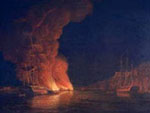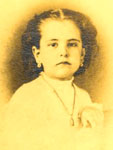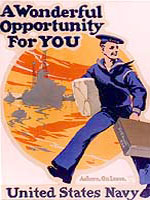1. On December 5th 1872, the Mary Celeste was found sailing empty of all crew, but with all valuables—including her cargo of raw alcohol—still aboard. The yawl (a small boat) was missing, and two cuts were made to the bow of the ship. Which of the following theories was proposed by one of the captain's relatives?
a. Warm weather made the alcoholic cargo release gas, causing cargo barrels to explode and the crew to abandon ship.
The captain's cousin, Oliver Cobb, and the vessel owner, J.H. Winchester, felt that the cargo caused minor explosions in the hold. Following the explosions, the ship would have been abandoned in extreme haste, as such explosions were known to splinter and sink vessels.
The official opinion on the Mary Celeste was that the crew sampled the alcohol, killed the captain and his family, damaged the bow of the brig to make the vessel appear unseaworthy, and waited for another captain to "save" them from their vessel. Others held that the ship was becalmed. As it slowly drifted toward shore, Briggs and his men set out in the yawl, to avoid being onboard if the ship wrecked. However, they did not tie the yawl to the Mary Celeste; and when the wind started again, the ship abandoned them. Many other theories exist, and this remains one of history's mysteries. (Incidentally, there were no African Americans among the crew—though Sir Arthur Conan Doyle wrote a fictionalized account in which African American crewman mutinied.)
2. In November 1819, a vessel was struck and wrecked by a sperm whale the crew had seen before, at previous whaling sites. What is the name of the ship?
b. The Essex
Having survived the wreck, 20 crewmembers set out from the Essex in small rowboats with minimal supplies. Over the course of three months, they floated about the South Seas, suffering from the heat, dehydration, and starvation. The evacuees eventually resorted to cannibalism when their food stores were depleted. Eight men survived, including the captain, James Pollard, Jr., and Owen Chase, author of the best-known firsthand account of the disaster. The story of the Essex inspired Herman Melville to write his famous novel Moby-Dick.
3. The 1904 loss of the New York excursion steamer the General Slocum resulted in over 400 dead. Which factor did not contribute to the loss of life?
b. Inaccurate nautical charts
 On June 15, 1904, the General Slocum departed on the annual Sunday School excursion of St. Mark's German Lutheran Church. However, unbeknownst to passengers and crew, a fire had broken out in a storage room. Many passengers died of burns, and others drowned, unable to swim. The steamer's defective life preservers added to the death toll. The preservers' insides, made of finely-ground cork, quickly became waterlogged when the preservers' rotten covers fell away. One survivor told of a woman with three children. The mother and two girls could swim, but one daughter could not. The daughter was put in a life preserver and tossed overboard, where she immediately sank.
On June 15, 1904, the General Slocum departed on the annual Sunday School excursion of St. Mark's German Lutheran Church. However, unbeknownst to passengers and crew, a fire had broken out in a storage room. Many passengers died of burns, and others drowned, unable to swim. The steamer's defective life preservers added to the death toll. The preservers' insides, made of finely-ground cork, quickly became waterlogged when the preservers' rotten covers fell away. One survivor told of a woman with three children. The mother and two girls could swim, but one daughter could not. The daughter was put in a life preserver and tossed overboard, where she immediately sank.
The General Slocum disaster was recognized internationally because of the loss of so many women and children.
4. In December 1717, Blackbeard captured the sloop Margaret. What did the pirates take from the ship?
c. Cutlasses, hogs, books, and navigational tools
Captain Henry Bostock reported his losses as cutlasses, hogs, books, and navigational instruments—not the traditional image of pirate booty. However, the hogs would provide fresh meat; the books provided entertainment on board a ship where the crew often had little to do (pirate crews could be roughly 80 men strong, as compared to the 12-man crew of a merchant vessel); and accurate navigation was crucial at sea. When we think of pirates and maps, we imagine mythical treasure maps, but maps were vital to any ship—the more the better, as they were often inaccurate by as much as 600 nautical miles. Also, pirates were essentially democratic, so crews determined destinations by common vote. As a result, pirate ships often took odd, zigzagging routes, rather than tried-and-true sea paths, making maps still more valuable.
 On June 15, 1904, the General Slocum departed on the annual Sunday School excursion of St. Mark's German Lutheran Church. However, unbeknownst to passengers and crew, a fire had broken out in a storage room. Many passengers died of burns, and others drowned, unable to swim. The steamer's defective life preservers added to the death toll. The preservers' insides, made of finely-ground cork, quickly became waterlogged when the preservers' rotten covers fell away. One survivor told of a woman with three children. The mother and two girls could swim, but one daughter could not. The daughter was put in a life preserver and tossed overboard, where she immediately sank.
On June 15, 1904, the General Slocum departed on the annual Sunday School excursion of St. Mark's German Lutheran Church. However, unbeknownst to passengers and crew, a fire had broken out in a storage room. Many passengers died of burns, and others drowned, unable to swim. The steamer's defective life preservers added to the death toll. The preservers' insides, made of finely-ground cork, quickly became waterlogged when the preservers' rotten covers fell away. One survivor told of a woman with three children. The mother and two girls could swim, but one daughter could not. The daughter was put in a life preserver and tossed overboard, where she immediately sank. If you are curious about the Mary Celeste, one interesting online resource is "
If you are curious about the Mary Celeste, one interesting online resource is "


